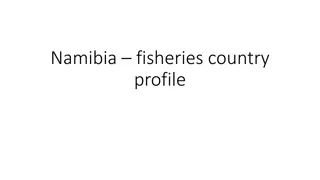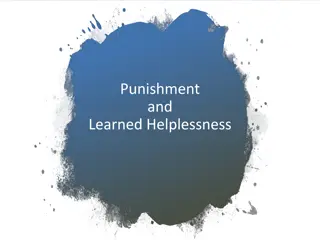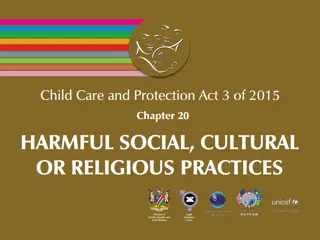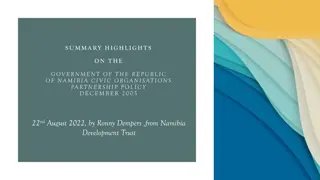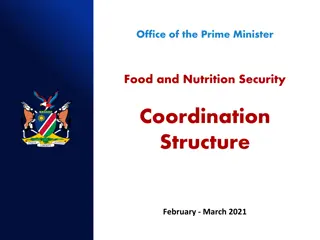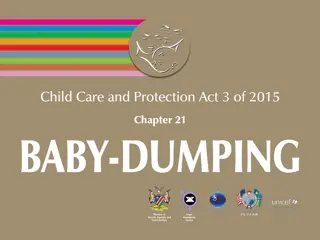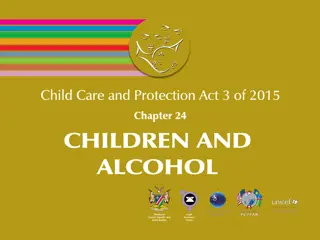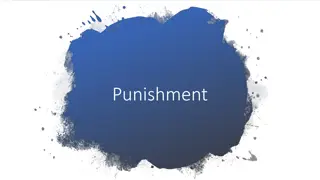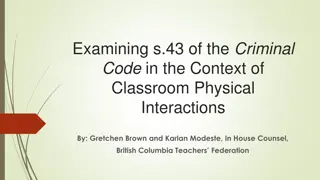Understanding the Child Care and Protection Act: Corporal Punishment in Namibia
The Child Care and Protection Act in Namibia prohibits corporal punishment and emphasizes respect for children's rights and dignity. It outlines forms of corporal punishment, constitutional and international frameworks supporting human dignity, and the importance of promoting alternatives to physical discipline. By recognizing and upholding children's rights, we can foster a culture of human rights and respect for all individuals.
Download Presentation

Please find below an Image/Link to download the presentation.
The content on the website is provided AS IS for your information and personal use only. It may not be sold, licensed, or shared on other websites without obtaining consent from the author. Download presentation by click this link. If you encounter any issues during the download, it is possible that the publisher has removed the file from their server.
E N D
Presentation Transcript
Child Care and Protection Act 3 of 2015 Chapter 22 CORPORAL PUNISHMENT Ministry of Gender Equality and Child Welfare Legal Assistance Centre
Overview The Child Care and Protection Act says that any person with control of a child, including the child s parents, must respect the child s right to dignity when disciplining the child. The Act also outlaws the use of corporal punishment in o any registered facility for children (including children s homes, shelters, cr ches and day care centres) o any form of alternative care by court order (such as foster care or court-ordered kinship care) o public and private schools o prisons and police cells. The Act also gives the Minister of Gender Equality and Child Welfare a duty to promote alternatives to corporal punishment.
1. What is corporal punishment? Corporal punishment is the application of physical force by a person in a position of authority with the intention of causing pain for disciplinary purposes. Corporal punishment of children in Namibia includes: slapping spanking beating with hand or object like a stick or a belt kicking, shaking, pinching or burning.
2. Constitutional and international frameworks Namibian Constitution Article 8: Respect for Human Dignity (1) The dignity of all persons shall be inviolable. (2) (a) In any judicial proceedings or in other proceedings before any organ of the State, and during the enforcement of a penalty, respect for human dignity shall be guaranteed. (b) No persons shall be subject to torture or to cruel, inhuman or degrading treatment or punishment.
International frameworks Many international and regional agreements which Namibia has joined guarantee respect for human dignity and prohibit use of degrading treatment or punishment. Universal Declaration of Human Rights Convention on the Rights of the Child International Covenant on Civil and Political Rights International Covenant on Economic and Social Rights Convention against Torture and Other Cruel, Inhuman or Degrading Treatment African Charter on Human and Peoples Rights African Charter on the Rights and Welfare of the Child
How can we expect children to take human rights seriously and to help build a culture of human rights, while we adults not only persist in slapping, spanking, smacking and beating them, but actually defend doing so as being for their own good ? Smacking children is not just a lesson in bad behaviour; it is a potent demonstration of contempt for the human rights of smaller, weaker people. Children s rights: Turning principles into practice, Stockholm: Save the Children Sweden, 2000
3. Corporal punishment of children in family settings Who is covered by this rule? Child Care and Protection Act, section 228(1) parent (biological/adoptive) legal custodian of child Corporal punishment by a person who has control of a child foster parent A person who has control of a child, including a person who has parental responsibilities and rights in respect of the child, must respect the child s right to dignity conferred by Article 8 of the Namibian Constitution. step-parent kinship care-giver person caring for child in a day care centre or health care facility domestic worker or babysitter
Consequences of corporal punishment in the home Corporal punishment could be prosecuted as assault (although emphasis is on encouraging positive discipline rather than criminalizing parents) could count against parent in future custody proceeding or custody dispute in divorce could be basis for removal of child from home and placement in alternative care as a form of domestic violence,could be basis for protection order
Corporal punishment as domestic violence The definition of domestic violence encompasses various forms of corporal punishment: physical abuse physical assault or any use of physical force, forcible confinement and physical deprivation of access to food, water, clothing, shelter or rest intimidation intentionally inducing fear by committing physical abuse or threatening to do so emotional, verbal or psychological abuse conduct which seriously degrades or humiliates a person or deprives them of privacy, liberty, integrity or security
4. Corporal punishment of children in alternative care The Act says that no person may use corporal punishment in any residential child care facility, foster care or any other form of alternative care resulting from a court order. Corporal punishment could be grounds for removal of the child and placement in another form of alternative care could result in cancellation of registration or removal of approval as a foster parent could also lead to a criminal charge of assault or a civil claim for damages.
5. Corporal punishment of children in places of care and shelters The Act says that no person may use corporal punishment at any place of care (where more than six children are cared for temporarily in terms of private arrangements with parents/care-givers) or shelter (facility for temporary accommodation of abused adults and children, street children or children who attend voluntarily). Corporal punishment could result in cancellation of registration or removal of approval as a foster parent could also lead to a criminal charge of assault or a civil claim for damages.
6. Corporal punishment of children in schools and ECD centres Namibian Supreme Court: ruled in 1991 that corporal punishment in State schools is a violation of children s constitutional right to dignity Education Act 16 of 2001: teachers or any other persons employed at a State or private school or hostel commit misconduct if they use corporal punishment on a learner in the course of their official duties Child Care and Protection Act: no corporal punishment in State/private schools or hostels; corporal punishment could result in o cancellation of registration o criminal charge of assault o civil claim for damages.
7. Corporal punishment of children in criminal justice settings Namibian Supreme Court: ruled in 1991 that corporal punishment of juvenile offenders is a violation of children s constitutional right to dignity Child Care and Protection Act: (1) repeals any law that authorizes corporal punishment of a child as a sentence by any court (including traditional court); (2) no corporal punishment in of children in prisons or police cells (covers juvenile offenders & children accompanying a parent or care-giver); corporal punishment could result in - o criminal charge of assault o civil claim for damages o disciplinary proceedings against police or correctional service personnel.
8. Why is corporal punishment bad for children? can turn into serious physical abuse teaches children that violence is an acceptable way to deal with issues teaches children that it is okay to use violence against someone you love makes children more aggressive towards other children children exposed to violence are more likely to become violent adults does not teach children the reason why their behaviour was wrong can affect self-esteem by making child feel scared, sad, ashamed or worthless can destroy the child's relationship with parent or caregiver.
Arguments for corporal punishment Arguments against corporal punishment Corporal punishment is part of my religious belief and culture. Other people interpret the same religious teachings to have a different meaning that does not justify the use of corporal punishment. Wife beating was also an accepted part of many cultures in the past, but this is now changing There is a difference between a vicious beating and a light spanking or smack. This is true, but it is difficult to judge how the punishment is perceived by the child who experiences it. Adults who administer corporal punishment are not always able to control themselves when they act in the heat of the moment. This is why serious injuries and even death have resulted from corporal punishment in Namibia.
Arguments for corporal punishment Arguments against corporal punishment Corporal punishment was used on me when I was a child, and I do not have any problems. Different people react differently to violence and aggression. It is undeniable that Namibia as a whole is suffering unhealthy levels of violence so something is not well with our society as a whole. Alternative forms of discipline could teach children nonviolent ways of problem solving. Discipline is meant to teach a child the difference between wrong and right. Corporal punishment is not effective in this regard, because it makes children comply out of fear instead of teaching them how they should behave.
9. Alternatives to corporal punishment Child Care and Protection Act, section 228(4) Promoting alternatives to corporal punishment The Minister must take all reasonable steps to ensure that (a) education and awareness raising programmes are implemented in all the regions in Namibia; and (b) programmes and materials promoting appropriate discipline at home and in other contexts where children are cared for are available in all the regions in Namibia.
Suggestions for positive discipline Give praise: This encourages children to model their behaviour through positive reinforcement and encourages them to learn self-discipline. Lead by example: Practice what you preach. Be realistic: Do not expect a child to behave in ways beyond the child s stage of development. There is no point in punishing a baby for crying because he or she is hungry. Restorative justice: Bring the victim and offender together to discuss how to repair any harm caused and how to prevent future misbehaviour. Explain: Help children understand the reasons for the rules. Use good words to describe children: Bad-mouthing and humiliation lower self-esteem and can become self- fulfilling prophesies.
Suggestions for positive discipline Be respectful: A child treated with respect will be more likely to act respectfully towards others. Negotiate a compromise: Sometimes it may be best to reconsider the demands being placed on the child and agree to a compromise that will not endanger the child s safety or hurt anyone else. Use guidance and counselling: Call on another teacher or relative or an older person in the family or community; ask this person to discuss problematic behaviour with the child and to provide guidance on expectations for the future. Children learn by doing: Give the child a task to perform that is related to what the child has done wrong. Children who must repair, clean or tidy something that they damaged or dirtied will be less likely to repeat that behaviour in future. ***




